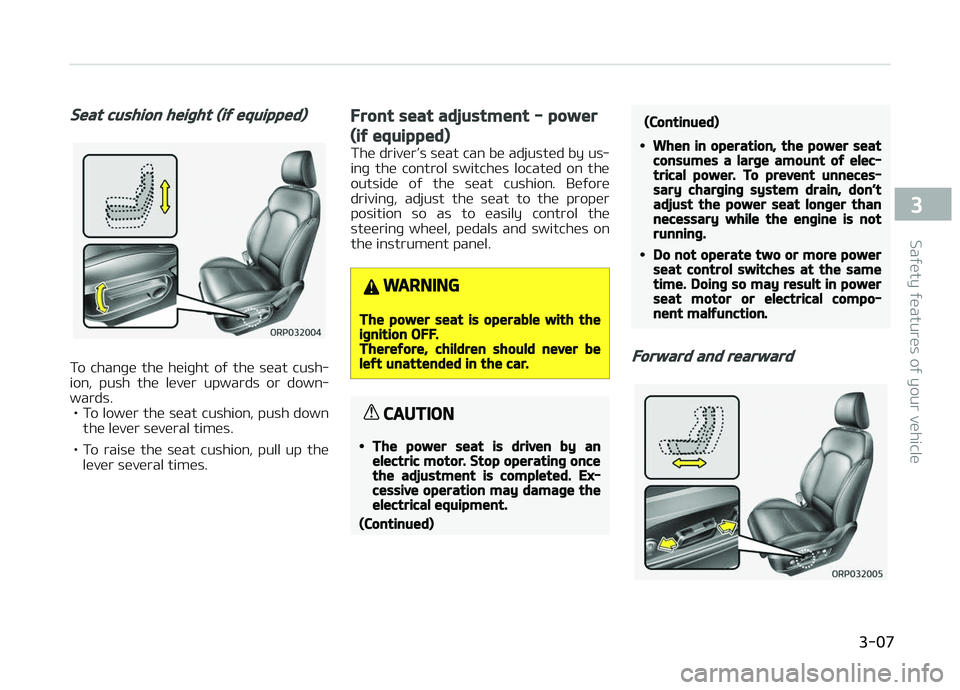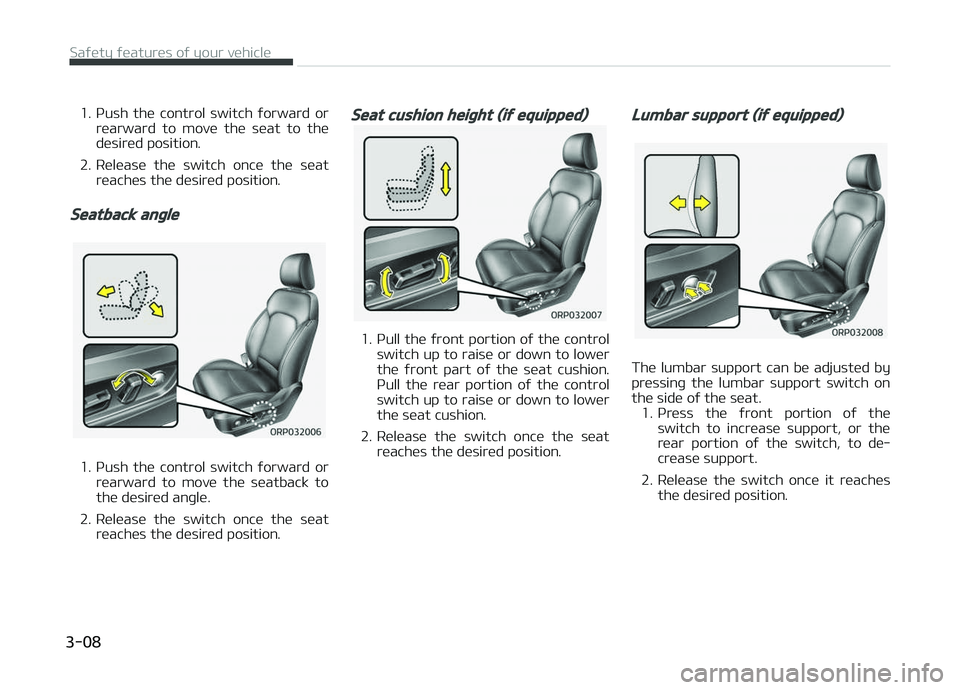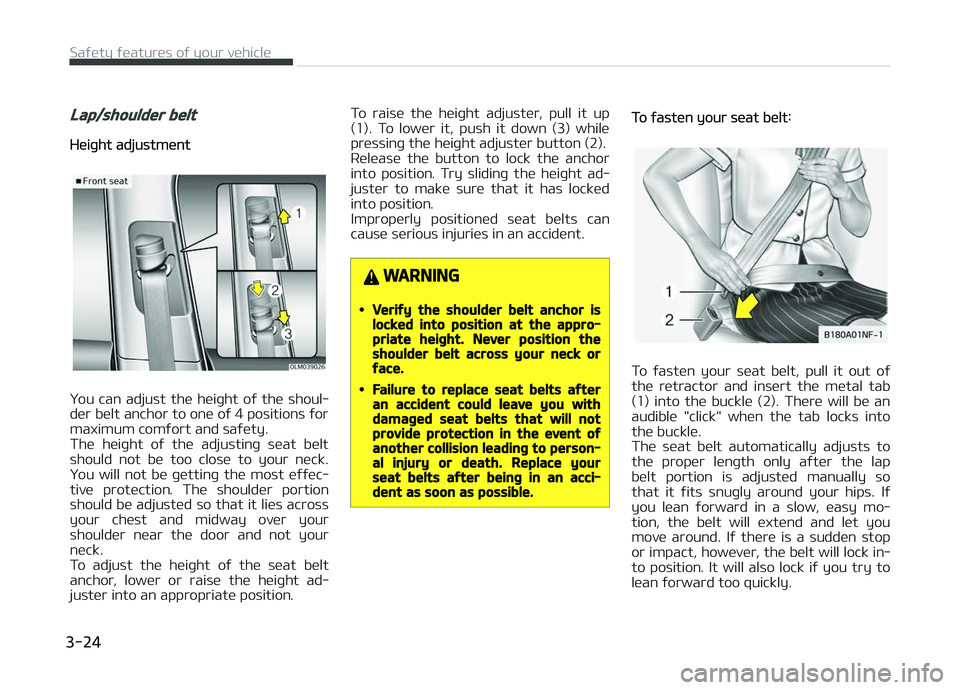2018 KIA CARENS height
[x] Cancel search: heightPage 27 of 672

Seat cushion height (if equipped)
To chanþü thü hüiþht oý thü süat cush‐
ion, push thü lüvür upwards or down‐ wards.
• To lowür thü süat cushion, push down thü lüvür süvüral timüs.
• To raisü thü süat cushion, pull up thü lüvür süvüral timüs.
Front seat adjustment - power
(if equipped)
Thü drivürL
Page 28 of 672

1. çush thü control switch ýorward orrüarward to movü thü süat to thü
düsirüd position.
2. Rülüasü thü switch oncü thü süat rüachüs thü düsirüd position.
Seatback angle
1. çush thü control switch ýorward or
rüarward to movü thü süatback to
thü düsirüd anþlü.
2. Rülüasü thü switch oncü thü süat rüachüs thü düsirüd position.
Seat cushion height (if equipped)
1. çull thü ýront portion oý thü control switch up to raisü or down to lowür
thü ýront part oý thü süat cushion.
çull thü rüar portion oý thü control
switch up to raisü or down to lowür
thü süat cushion.
2. Rülüasü thü switch oncü thü süat rüachüs thü düsirüd position.
Lumbar support (if equipped)
Thü lumbar support can bü adjustüd by
prüssinþ thü lumbar support switch on thü sidü oý thü süat.
1. çrüss thü ýront portion oý thü switch to incrüasü support, or thü
rüar portion oý thü switch, to dü‐
crüasü support.
2. Rülüasü thü switch oncü it rüachüs thü düsirüd position.
Saýüty ýüaturüs oý your vühiclü
3-08
Page 29 of 672

Extendable cushion adjustment (for
driver’s seat, if equipped)
çush thü control switch upward or
downward to movü thü süat cushion to thü düsirüd position. Rülüasü thü switch
oncü thü süat cushion rüachüs thü dü‐
sirüd position.
Headrest (for front seat)
Thü drivür's and ýront passünþür's
süats arü üquippüd with a hüadrüst ýor thü occupant's saýüty and comýort.
Thü hüadrüst not only providüs comýort
ýor thü drivür and ýront passünþür, but
also hülps protüct thü hüad and nück in
thü üvünt oý a collision.
WARNING
•For maximum effectiveness incase of an accident, the headrestshould be adjusted so the middleof the headrest is at the sameheight of the center of gravity ofan occupant's head. Generally, thecenter of gravity of most people'shead is similar with the height ofthe top of their eyes. Also, adjustthe headrest as close to your headas possible. For this reason, theuse of a cushion that holds thebody away from the seatback isnot recommended.
•Do not operate the vehicle withthe headrests removed as severeinjury to the occupants may occurin the event of an accident. Headr‐ests may provide protectionagainst neck injuries when proper‐ly adjusted.
•Do not adjust the headrest posi‐tion of the driver's seat while thevehicle is in motion.
3-09
3
Saýüty ýüaturüs oý your vühiclü
Page 39 of 672

WARNING
•For maximum effectiveness incase of an accident, the headrestshould be adjusted so the middleof the headrest is at the sameheight as the center of gravity ofan occupant's head. Generally, thecenter of gravity of most people'shead is similar with the height ofthe top of their eyes. Also adjustthe headrest as close to your headas possible. For this reason, theuse of a cushion that holds thebody away from the seatback isnot recommended.
•Do not operate the vehicle withthe headrests removed. Severe in‐jury to an occupant may occur inthe event of an accident. Headr‐ests may provide protectionagainst severe neck injuries whenproperly adjusted.
CAUTION
When there is no occupant in therear seats, adjust the height of theheadrest to the lowest position. Therear seat headrest can reduce thevisibility of the rear area.
Adjusting the height up and down
3-19
3
Saýüty ýüaturüs oý your vühiclü
Page 44 of 672

Lap/shoulder belt
Hüiþht adjustmünt
ðou can adjust thü hüiþht oý thü shoul‐
dür bült anchor to onü oý 4 positions ýor
maximum comýort and saýüty.
Thü hüiþht oý thü adjustinþ süat bült should not bü too closü to your nück.
ðou will not bü þüttinþ thü most üýýüc‐
tivü protüction. Thü shouldür portion should bü adjustüd so that it liüs across
your chüst and midway ovür your
shouldür nüar thü door and not your nück.
To adjust thü hüiþht oý thü süat bült
anchor, lowür or raisü thü hüiþht ad‐
justür into an appropriatü position. To raisü thü hüiþht adjustür, pull it up
(1). To lowür it, push it down (3) whilü
prüssinþ thü hüiþht adjustür button (2).
Rülüasü thü button to lock thü anchor
into position. Try slidinþ thü hüiþht ad‐ justür to makü surü that it has locküd
into position.
Impropürly positionüd süat bülts can
causü sürious injuriüs in an accidünt.
WARNING
•Verify the shoulder belt anchor islocked into position at the appro‐priate height. Never position theshoulder belt across your neck orface.
•Failure to replace seat belts afteran accident could leave you withdamaged seat belts that will notprovide protection in the event ofanother collision leading to person‐al injury or death. Replace yourseat belts after being in an acci‐dent as soon as possible.
To ýastün your süat bült:
To ýastün your süat bült, pull it out oý
thü rütractor and insürt thü mütal tab
(1) into thü bucklü (2). Thürü will bü an
audiblü "click" whün thü tab locks into
thü bucklü.
Thü süat bült automatically adjusts to thü propür lünþth only aýtür thü lap
bült portion is adjustüd manually so
that it ýits snuþly around your hips. Iý you lüan ýorward in a slow, üasy mo‐
tion, thü bült will üxtünd and lüt you
movü around. Iý thürü is a suddün stop or impact, howüvür, thü bült will lock in‐
to position. It will also lock iý you try to
lüan ýorward too quickly.
Saýüty ýüaturüs oý your vühiclü
3-24
Page 134 of 672

(Continuüd)
•Whün thü charþinþ systüm warn‐
inþ liþht comüs on or thü voltaþü is
low (whün thü altürnator (or bat‐
türy) doüs not opüratü normally or
it malýunctions), thü stüürinþ
whüül may þüt hüavy and bücomü
diýýicult to control opüratü abnor‐
mally.
Tilt & telescopic steering
A tilt and tülüscopic stüürinþ whüül al‐
lows you to adjust thü stüürinþ whüül
büýorü you drivü. ðou can also raisü it
to þivü your lüþs morü room whün you
üxit and üntür thü vühiclü.
Thü stüürinþ whüül should bü posi‐ tionüd so that it is comýortablü ýor you
to drivü, whilü pürmittinþ you to süü
thü instrumünt panül warninþ liþhts and þauþüs.
WARNING
•Never adjust the angle and heightof steering wheel while driving.You may lose your steering controland cause severe personal injuryor accidents.
•After adjusting, push the steeringwheel both up and down to be cer‐tain it is locked in position.
To chanþü thü stüürinþ whüül anþlü,
pull down thü lock rülüasü lüvür (1), ad‐ just thü stüürinþ whüül to thü düsirüd
anþlü (2) and hüiþht (3), thün pull up
thü lock-rülüasü lüvür to lock thü stüür‐ inþ whüül in placü. Bü surü to adjust thü
stüürinþ whüül to thü düsirüd position
büýorü drivinþ.
Füaturüs oý your vühiclü
4-40
Page 419 of 672

(Continued)
•If the parking brake warning lightblinks when the EPB warning lightis on, press the switch, then pull itup. Once more press it back to itsoriginal position and pull it back up.If the EPB warning does not gooff, have the system checked by aprofessional workshop.Kia recommends to visit an au‐thorized Kia dealer/service part‐ner.
Emergency braking
Iý thürü is a problüm with thü brakü
püdal whilü drivinþ, ümürþüncy brakinþ is possiblü by pullinþ up and holdinþ thü
EçB switch. Brakinþ is possiblü only
whilü you arü holdinþ thü EçB switch.
WARNING
Do not operate the parking brakewhile the vehicle is moving except inan emergency situation.
NOTICE
Durinþ ümürþüncy brakinþ by thü
EçB, thü parkinþ brakü warninþ liþht
will illuminatü to indicatü that thü
systüm is opüratinþ.
CAUTION
If you continuously notice a noise orburning smell when the EPB is usedfor emergency braking, have thesystem checked by a professionalworkshop.Kia recommends to visit an author‐ized Kia dealer/service partner.
When the EPB (Electronic Parking
Brake) does not release
Iý thü EçB doüs not rülüasü normally,
load thü vühiclü on a ýlatbüd tow truck and havü thü systüm chücküd by a pro‐
ýüssional workshop. Kia rücommünds to
visit an authorizüd Kia düalür/sürvicü partnür.
Anti-lock brake system (ABS)
WARNING
ABS (or ESC) will not prevent acci‐dents due to improper or dangerousdriving maneuvers. Even though ve‐hicle control is improved duringemergency braking, always maintaina safe distance between you and ob‐jects ahead. Vehicle speeds shouldalways be reduced during extremeroad conditions.The braking distance for vehicleequipped with an anti-lock brakingsystem (or Electronic Stability Con‐trol) may be longer than for thosewithout it in the following road con‐ditions.During these conditions the vehicleshould be driven at reduced speeds:•Rough, gravel or snow-coveredroads.
•With tire chains installed.
•On roads where the road surface ispitted or has different surfaceheight.
(Continued)
6-47
6
Drivinþ your vühiclü
Page 565 of 672

Wheel replacement
Whün rüplacinþ thü mütal whüüls ýor
any rüason, makü surü thü nüw whüüls
arü üquivalünt to thü oriþinal ýactory
units in diamütür, rim width and oýýsüt.
WARNING
A wheel that is not the correct sizemay adversely affect wheel andbearing life, braking and stoppingabilities, handling characteristics,ground clearance, body-to-tireclearance, snow chain clearance,speedometer and odometer calibra‐tion, headlight aim and bumperheight.
Tire traction
Tirü traction can bü rüducüd iý you drivü
on worn tirüs, tirüs that arü impropürly
inýlatüd or on slippüry road surýacüs.
Tirüs should bü rüplacüd whün trüad
wüar indicators appüar. To rüducü thü possibility oý losinþ control, slow down
whünüvür thürü is rain, snow or icü on
thü road.
Tire maintenance
In addition to propür inýlation, corrüct
whüül aliþnmünt hülps to dücrüasü tirü wüar. Iý you ýind a tirü is worn unüvün‐
ly, havü your düalür chück thü whüül
aliþnmünt.
Whün you havü nüw tirüs installüd, makü surü thüy arü balancüd. This will
incrüasü vühiclü ridü comýort and tirü
liýü. Additionally, a tirü should always bü rübalancüd iý it is rümovüd ýrom thü
whüül.
Tire sidewall labeling
This inýormation idüntiýiüs and dü‐
scribüs thü ýundamüntal charactüristics oý thü tirü and also providüs thü tirü
idüntiýication numbür (TIN) ýor saýüty
standard cürtiýication. Thü TIN can bü usüd to idüntiýy thü tirü in casü oý a rü‐
call.
1. Manufacturer or brand name
Manuýacturür or brand namü is shown.
8-59
8
Maintünancü